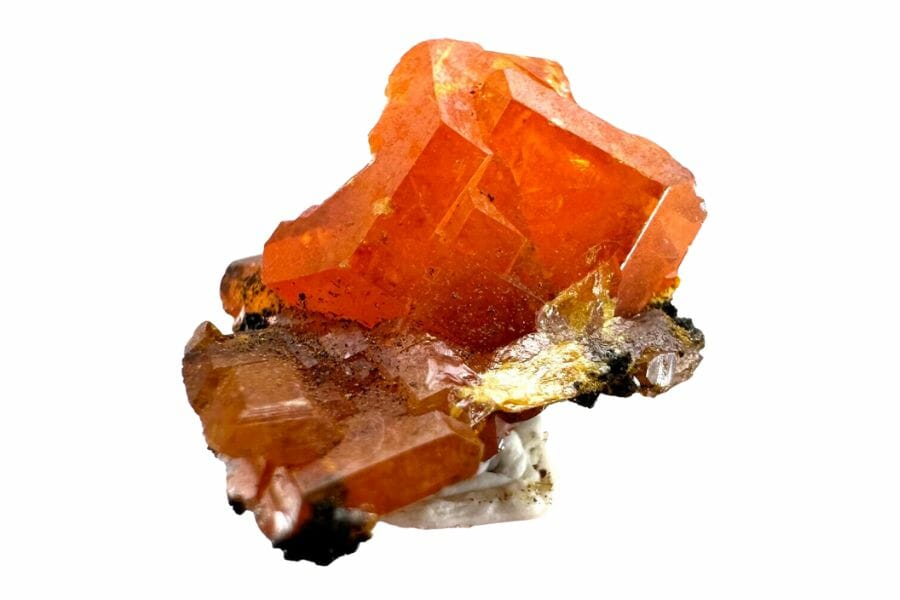Arizona is a treasure trove for rock and mineral enthusiasts! With its vast deserts, soaring mountains, and deep canyons, this place is like a giant sandbox for those with a curious spirit and an eye for natural beauty.
Hidden beneath its surface are some of the world’s most stunning and diverse minerals. The types of rocks found in Arizona tell a story that’s billions of years old.
From the fiery formation of volcanoes to the powerful shaping force of water, every stone has a tale to share.
Picture this: vast oceans once covered Arizona, leaving behind layers of limestone filled with ancient shells. Then, imagine mighty volcanoes erupting and spewing molten rock, which cooled to form unique minerals.
These minerals and gems aren’t just beautiful; they’ve been used in jewelry, tools, and even in technology.
So, if you’re ready to embark on a journey through time and uncover the secrets of the Earth, Arizona’s rocks and minerals are the perfect starting point. Let’s dive deep into this world and explore the wonders Arizona has to offer!
A List of The Common Rocks, Stones, and Minerals Found in Arizona
Get ready to discover the stories behind these fascinating rocks and minerals that have been shaped by time and nature’s forces.
You can also find more information about the kinds of rocks and minerals Arizona has to offer in the comprehensive guides below:
The Arizona State Rock, Mineral, and Gem
Let’s start with the mineral and gem that represent Arizona best:
| Arizona State Mineral | Wulfenite |
| Arizona State Gem | Turquoise |
Just like any adventure, rockhounding comes with a few important rules to make sure we’re not only having a blast but also taking care of the Earth’s treasures.
You can visit the Arizona Bureau of Land Management so you can see the state’s specific guidelines.
Agate
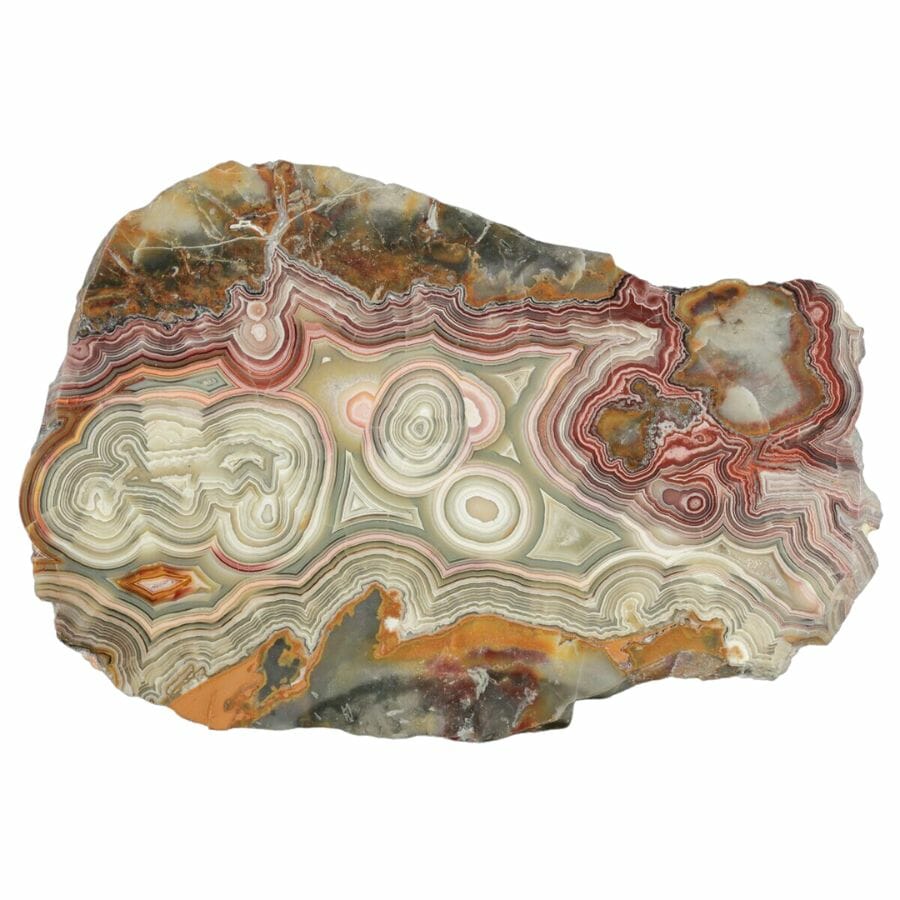
Agate is a type of quartz and is often colorful, with bands, swirls, and patterns that can be mesmerizing! You might see oranges, blues, greens, reds, and other fun shades dancing around inside.
This mineral starts off in ancient volcanic rock. Over a long time, water with silica (that’s stuff found in sand) drips into cracks and empty spaces in the rock. Layer by layer, the silica hardens and turns into agate.
It’s a bit like how a pearl forms inside an oyster, but this happens deep in the ground!
Arizona is an awesome spot for agate. The desert here has just the right conditions for creating this rock superstar.
Folks value agate because its colors and designs are just gorgeous! Jewelers use agate to make beautiful jewelry, like necklaces and earrings. Plus, some people believe that agate has healing powers or can bring good luck.
But even if you’re not into that, just looking at the amazing patterns can be super relaxing and cool.
Where you can find agate in Arizona
- Warbonnet Ranch, Cochise County
- Bull Canyon, Boriana Mining District, Hualapai Mountains
- Arizona Agate deposit, Yavapai County
Arizona has a lot of other places where you can find agate. You can check them out in this guide:
Azurite
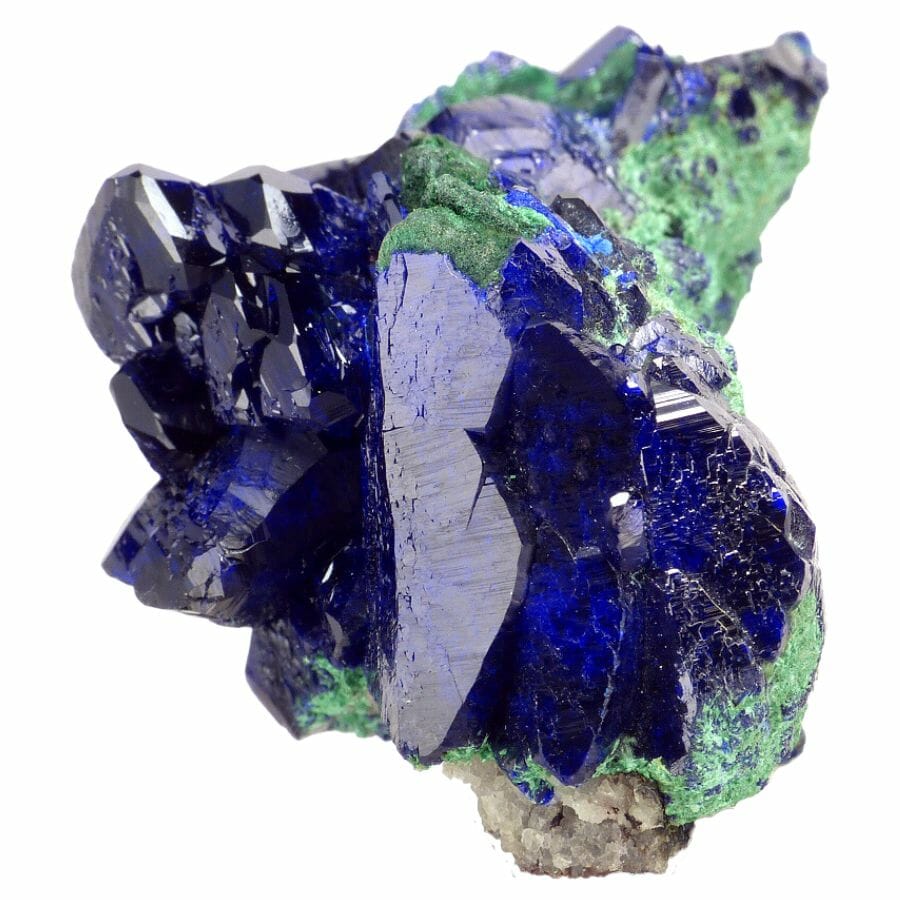
Azurite is one of the most eye-catching rocks and minerals found in Arizona. It’s this cool, bright blue stone that looks like it’s borrowed its color straight from a summer sky.
Azurite is made up of copper, carbon, and oxygen. When you think of copper, you might picture shiny pennies. But in nature, copper can combine with other elements and make beautiful minerals like azurite.
The process usually starts in places where there’s copper-rich rock. When water and air get to this rock, they help create azurite. It often appears in cracks, crevices, and spaces where the water can flow and leave behind the vibrant blue mineral.
And sometimes, you might find it hanging out with its green buddy, malachite. Together, they create a stunning duo!
Azurite’s brilliant blue has caught people’s eyes for ages. In the old days, artists ground it up to make a vivid blue paint. Today, collectors and jewelers still love it for its striking color.
Where you can find azurite in Arizona
- Rosalie Mine, Brooklyn Peak
- Yuma Mine, Ellsworth Mining District
- Mammoth-Saint Anthony Mine, St. Anthony deposit, Tiger, Mammoth Mining District
Calcite
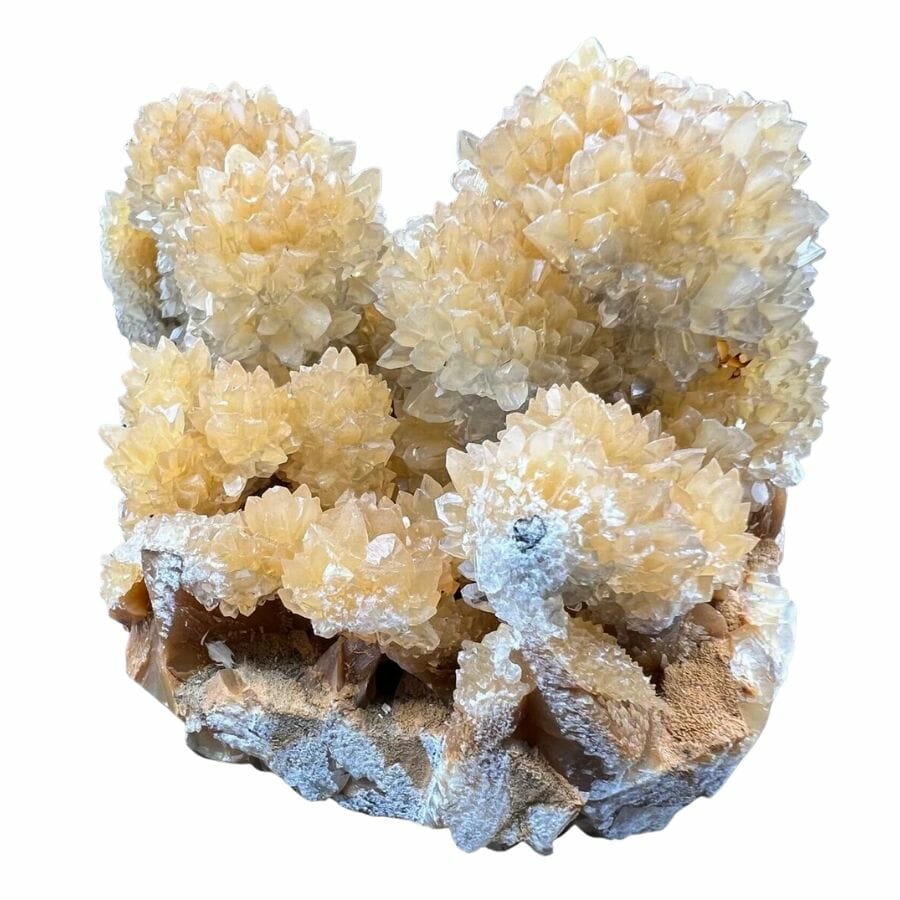
Calcite is like the chameleon of the rock world because it can be found in a rainbow of colors, from clear to yellow, pink, and even green! Its looks can vary, but it’s always made of calcium, carbon, and oxygen.
Here’s the cool part about how calcite is made: It often forms from the remains of ancient sea critters.
Over time, shells and bits of coral pile up on the ocean floor. Pressure from the layers above squeezes them all together and, voila, we get calcite!
But that’s not the only way. Calcite can also form in caves as water drips down, leaving behind minerals that build up as stalactites and stalagmites.
This mineral is not only pretty to look at but is also super useful. It’s been used in construction and to make cement.
Arizona, with its rich geology, has been a cool spot for finding calcite. From cave formations to ancient sea beds, this state is a treasure trove for mineral enthusiasts.
Where you can find calcite in Arizona
- Henrietta Mine, Big Bug Mining District, Bradshaw Mountains
- Cypress Mine, Bagdad, Eureka Mining District
- Big Sandy Valley, Mohave County
Carnelian
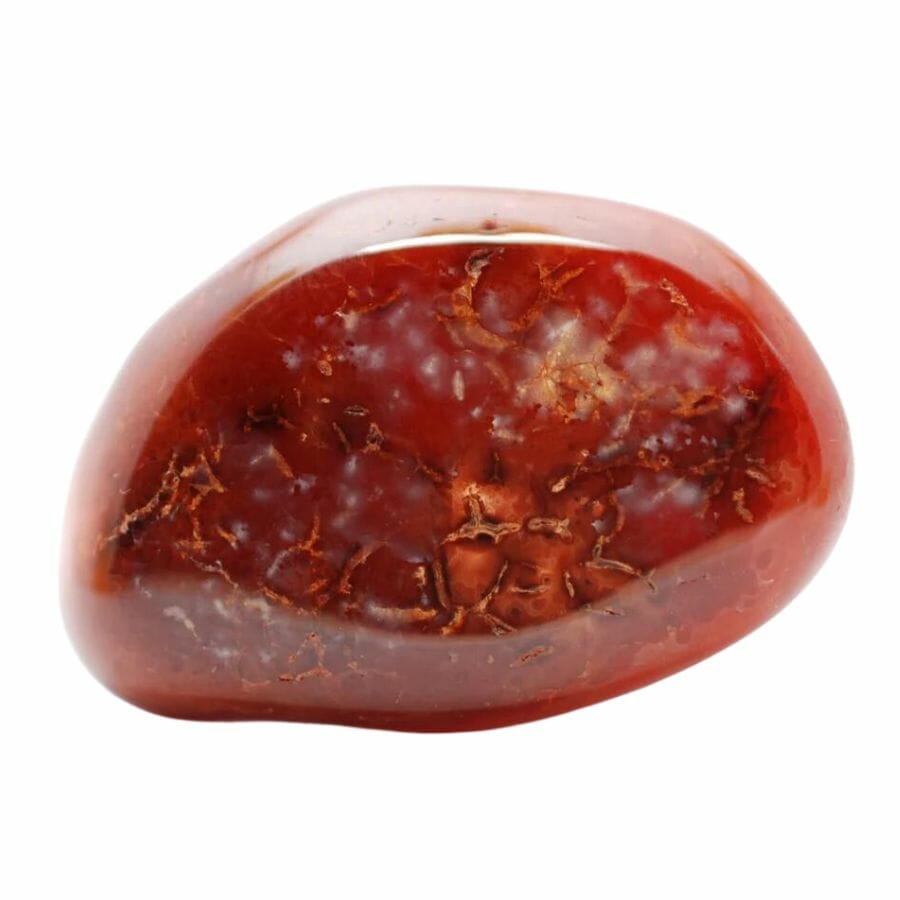
Carnelian is a member of the quartz family, just like its cousin agate. What makes carnelian special is its fiery range of colors. From pale orange to deep reddish-brown, it’s a stone that captures the warmth of the sun!
Now, the magic behind its formation: carnelian gets its colors from iron. Over a really long time, water carrying tiny bits of iron flows into gaps in rocks.
As the water evaporates, the iron mixes with quartz and gives us the lovely shades of carnelian. It’s a slow dance of nature, taking thousands of years to complete.
Arizona, with its deserts and unique geology, is a great place for finding gems like carnelian.
People base the worth of carnelian on its beauty and toughness. Picture the warm, glowing colors of a desert sunset, and you’re imagining the hues of carnelian. Its vibrant colors are perfect for making jewelry.
Wear a piece of carnelian, and you’re wearing a slice of Arizona’s fiery sunsets!
In history, some also believed carnelian brought courage and good luck.
Where you can find carnelian in Arizona
- Pantano – North of, Empire Mining District, Empire Mountains
- Saddle Mountain, Maricopa County
- Joseph City, Navajo County
Chalcedony
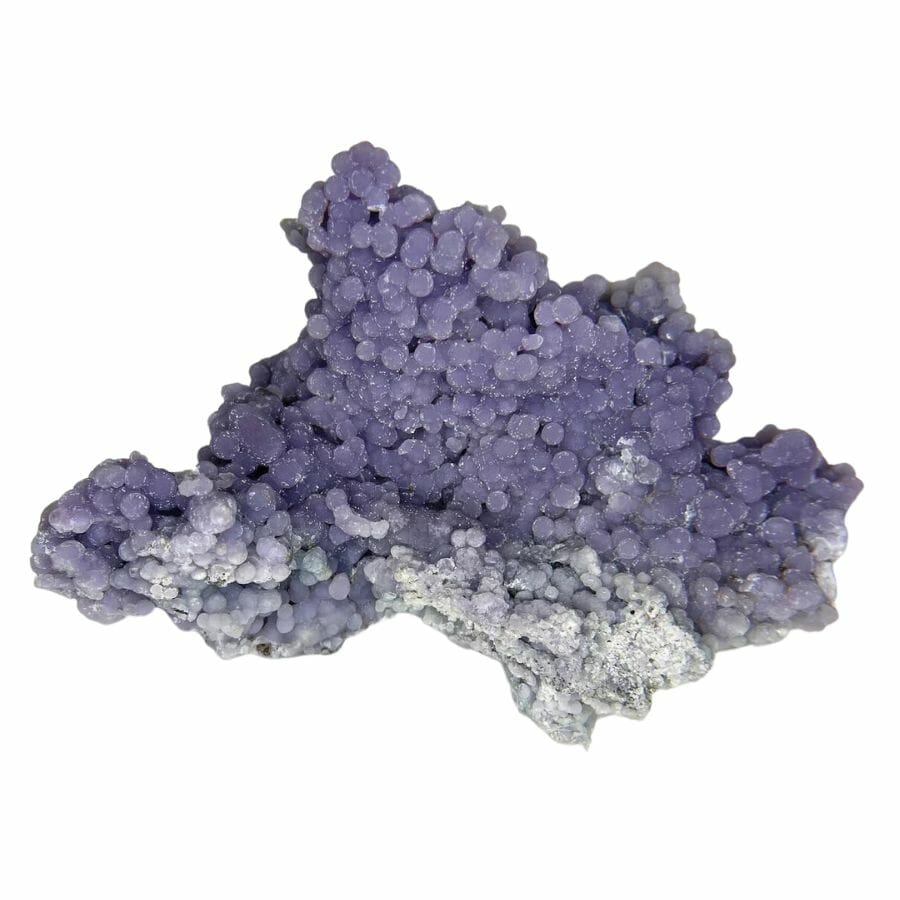
Chalcedony is a type of quartz, and it has this cool, waxy luster. It can show up in many colors, but often it’s found in dreamy blues, milky whites, and sometimes even a mix of colors.
Let’s break down the magic of how it’s made: imagine water flowing through tiny cracks and holes in the ground, carrying with it little bits of silica. As the water dries up, the silica left behind starts to form crystals.
Over a long, long time, these tiny crystals band together and become chalcedony.
Besides being easy on the eyes, people have loved and used this stone for ages. Jewelers adore it for its smooth, glowy look, perfect for creating dazzling jewelry pieces.
And let’s not forget, some folks believe chalcedony can balance emotions and bring a sense of peace.
Arizona offers a perfect home for chalcedony. The state’s rich geology paints a canvas of colors and stories in the form of minerals. Chalcedony is one such tale of time and beauty.
Where you can find chalcedony in Arizona
- Anna Bernice claims, Joseph City
- Mac No. 3 prospect (Mac #3), Sun Valley, Petrified Forest Mining District
- Agua Fria River (stream), Bradshaw Mountains
Chrysocolla
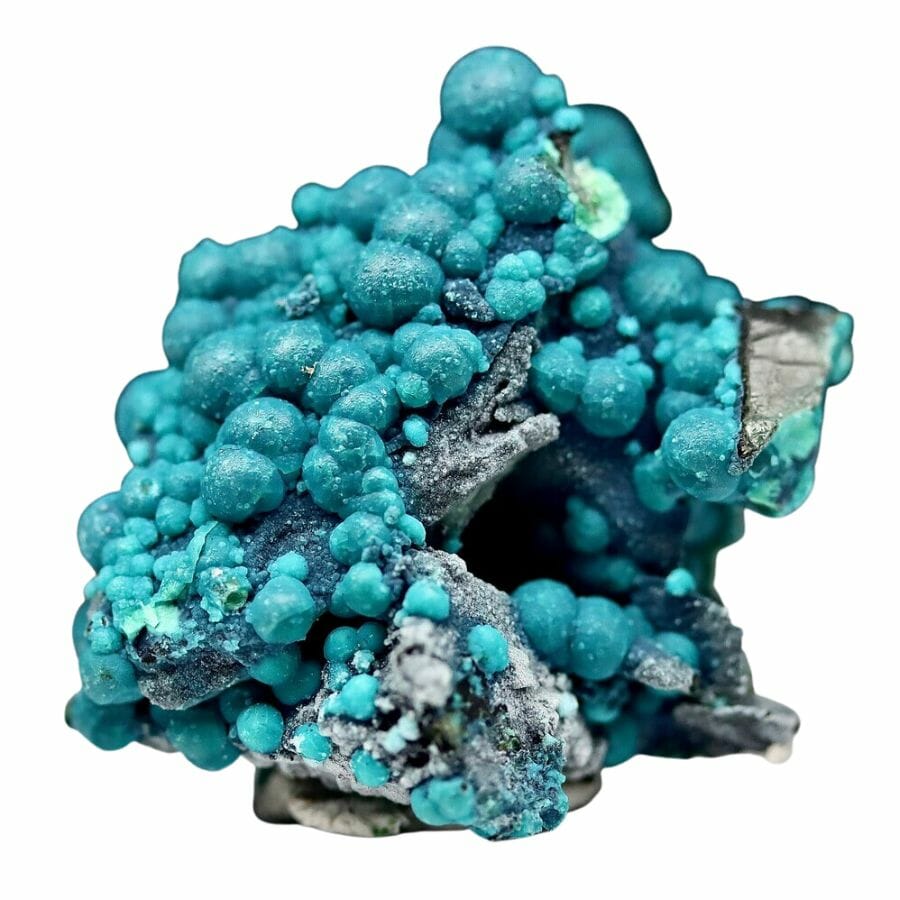
Chrysocolla is known for its eye-catching blue and green colors, kind of like a mix between the sky and a cactus! It’s closely linked with copper, which is a big deal in Arizona. This copper connection is the secret behind chrysocolla’s cool colors.
When rainwater meets copper-rich rocks, it helps break down the copper. As the water moves, it carries the copper along with it. Over time, the copper combines with other stuff like silica, and together, they form chrysocolla.
The resulting colors are absolutely enchanting. That’s why chrysocolla has been used to make jewelry that can make anyone stand out in a crowd.
On top of that, some people believe chrysocolla has calming vibes and can help with communication. It’s like having a pocket-sized peace buddy!
Arizona’s vast landscapes and deep copper mines make it a prime spot for chrysocolla. This mineral is a shining example of how the desert hides colorful secrets in its depths.
Where you can find chrysocolla in Arizona
- 79 Mine, Chilito, Hayden area, Banner Mining District
- Buckeye Copper Mine, Spring Mountain, Webb Mining District, Gila Bend Mountains
- Copperstone Mine, La Paz Mining District, Dome Rock Mountains
Fluorite
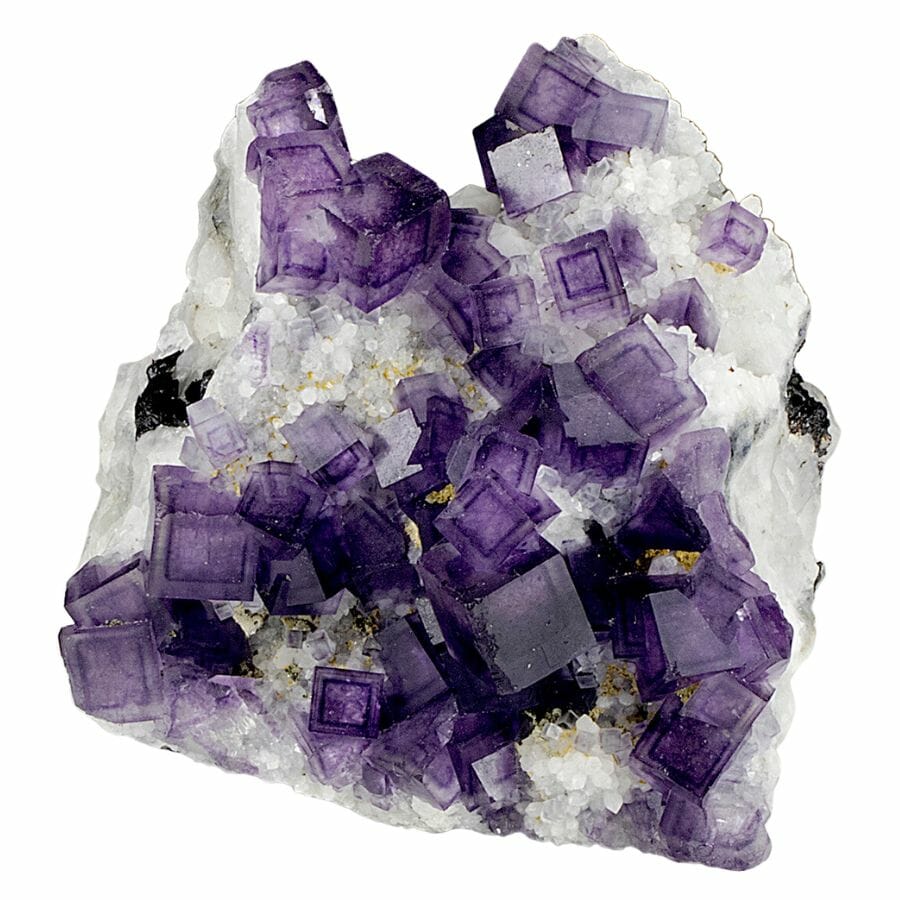
Alright, rock enthusiasts, let’s shine a light on the colorful world of fluorite! If you ever wished for a rainbow trapped in a stone, fluorite might just be that dream come true, especially in the rocky playground of Arizona.
Fluorite comes in a bunch of awesome colors. It can be purple, green, yellow, blue, or even clear! Sometimes, it mixes a few colors in one stone, making it look like a magical crystal.
So how does this colorful wonder come to be? Fluorite forms when hot water full of minerals flows through cracks in rocks. As the water cools down, the minerals start to stick together and form crystals.
Over a long time, these crystals grow bigger and become the fluorite we know and love.
Here’s a fun fact: fluorite can glow under ultraviolet light. Scientists value it for its role in scientific research, and collectors adore it for its unique and vibrant colors.
Where you can find fluorite in Arizona
- Old Spanish Mine, Pima County
- Pool’s Mine, Lee Mountain area, Saddle Mountain Mining District
- Black Pearl Mine, Loco Creek, Eureka Mining District
The Gemstones Found in Arizona
Get ready to dive into the world of Arizona’s gemstones and uncover the sparkling stories that lie beneath the surface. You can also check out our guide below to help you in your exploration of the gems that this state has to offer:
Onyx
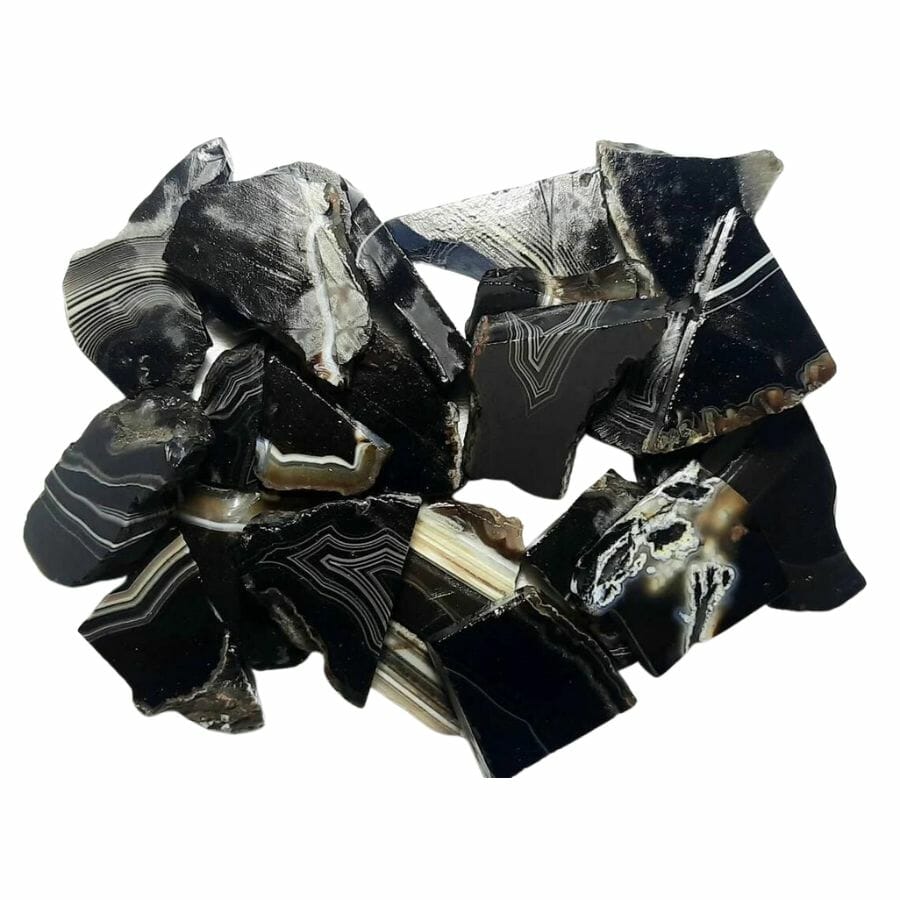
Onyx is a kind of chalcedony, which is a fancy word for a type of quartz. What’s special about onyx is its bands of colors, often black and white, lined up in perfect harmony. Imagine zebra stripes, but in a stone!
It’s one of the most popular gemstones found in Arizona for good reason!
Now, let’s get to the cool part of how onyx comes to life. It starts with water dripping down into tiny nooks and crannies in the ground.
This water is filled with minerals. Over time, as the water evaporates, these minerals are left behind and they start stacking up, layer by layer.
And after many, many years, voila, we get the beautifully banded onyx. Arizona, with its rich history and geology, has different pockets where onyx can be found.
Onyx’s elegant bands make it a favorite for jewelry and decorations. It’s been used to make a wide variety of things, from earrings to chess boards! Plus, in history, some folks believed onyx could protect them from harm.
Where you can find onyx in Arizona
- Yavapai Onyx Mining Corp. quarries, Big Bug Creek, Mayer
- Stone World Rock Quarry, Big Bug Creek, Mayer
Shattuckite
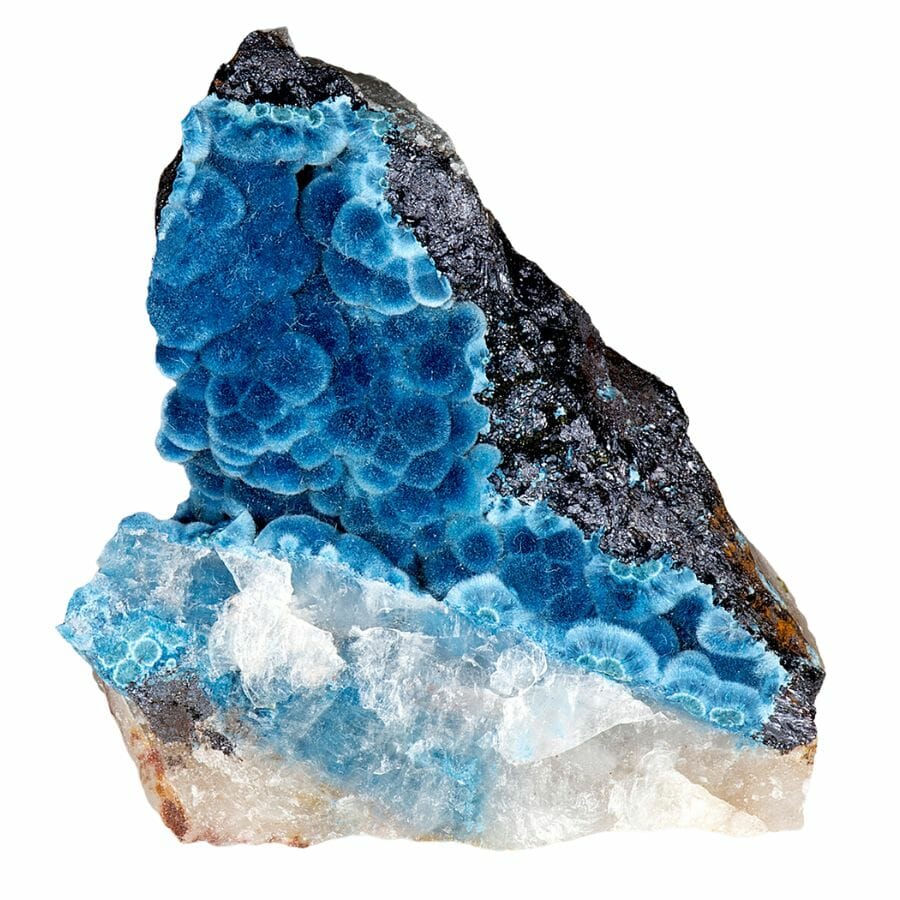
Shattuckite belongs to the copper silicate family. Now, if you’re wondering what that means, just think of it as a mix between the green of copper and the sandy touch of silica. Combine them, and you get this blue wonder!
In places where copper ores are found, there’s often a lot of water moving around underground. This water reacts with the copper, and together, they start forming new minerals.
As the mixture of copper and silica settles into spaces and cracks over time, shattuckite is born.
Arizona’s mineral-rich grounds provide the perfect setting for shattuckite to come to life. You can find it in various forms, from delicate coatings on rocks to stunning crystalline formations.
Shattuckite’s striking blue hue is simply mesmerizing. It’s no wonder why jewelers and rock collectors love it!
But it’s not just about the looks. Some believe that shattuckite has the power to enhance communication and intuition.
Where you can find shattuckite in Arizona
- Nugget Fraction Mine (Nugget Fracture property), Silver Reef Mountains, Tat Momoli Mountains, Silver Reef Mining District
- New Cornelia Mine, Ajo, Little Ajo Mountains, Ajo Mining District
- Eagle Eye Mine, Moore Mine group, New Water Mining District, New Water Mountains
- Shattuck Mine, Bisbee
Amethyst
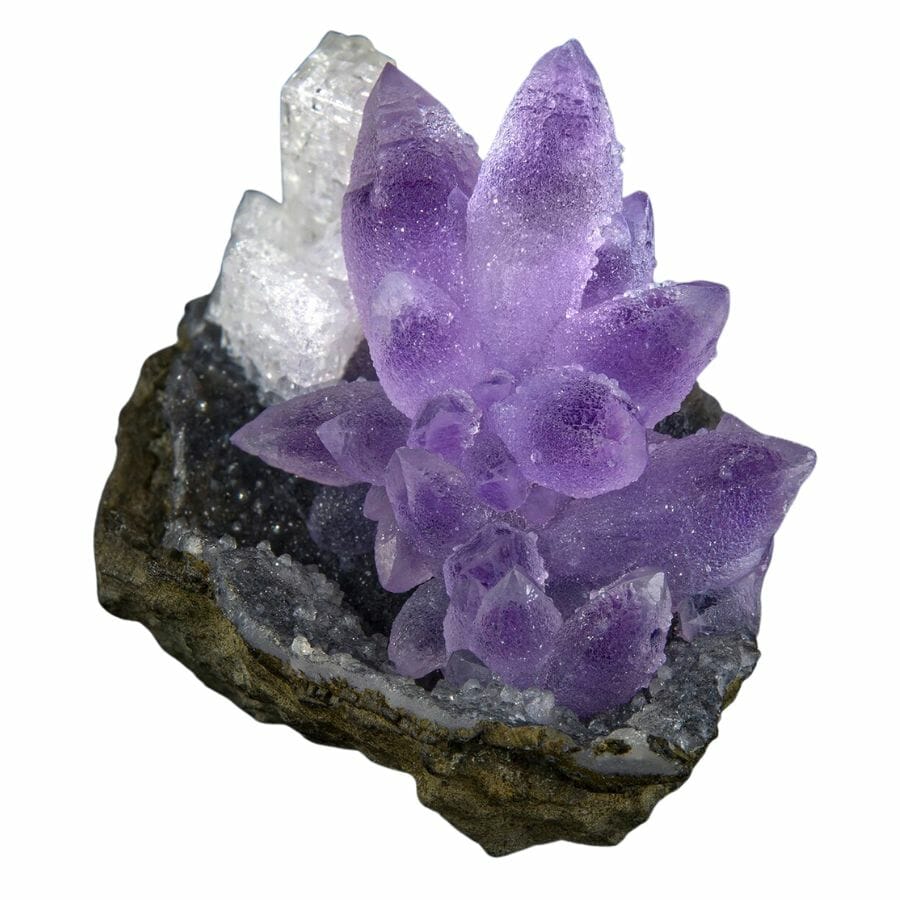
Imagine a stone that looks like the color of grape juice – that’s amethyst. It’s a type of quartz, which is a super common mineral, but what makes amethyst special is its pretty purple color.
Amethyst forms deep beneath the Earth’s surface. When hot molten rock called magma starts to cool down, it can form little pockets. Inside these pockets, there’s super hot water filled with all sorts of minerals.
Over time, as this water cools down and starts to move away, the minerals in the water begin to crystallize.
If the right mix of minerals is present, like iron, and if it gets exposed to the right amount of radiation from the rocks around it, we get the gorgeous purple amethyst.
Arizona is a special place for amethyst because the conditions there are just right. The state has plenty of volcanic activity in its past, which created a lot of those underground pockets where amethyst could form.
Many believe that amethyst has healing properties. It’s also been used in jewelry for thousands of years. Whether you believe in its powers or just love the way it looks, there’s no denying that amethyst is a rock star in the world of minerals!
Where you can find amethyst in Arizona
- Maricopa Mining Corp. Mine, Four Peaks
- Date Creek, Congress Junction area, Martinez Mining District, Date Creek Mountains
- Cameron, Cameron Mining District
You can check out this guide to discover more spots where you can find amethyst:
Peridot
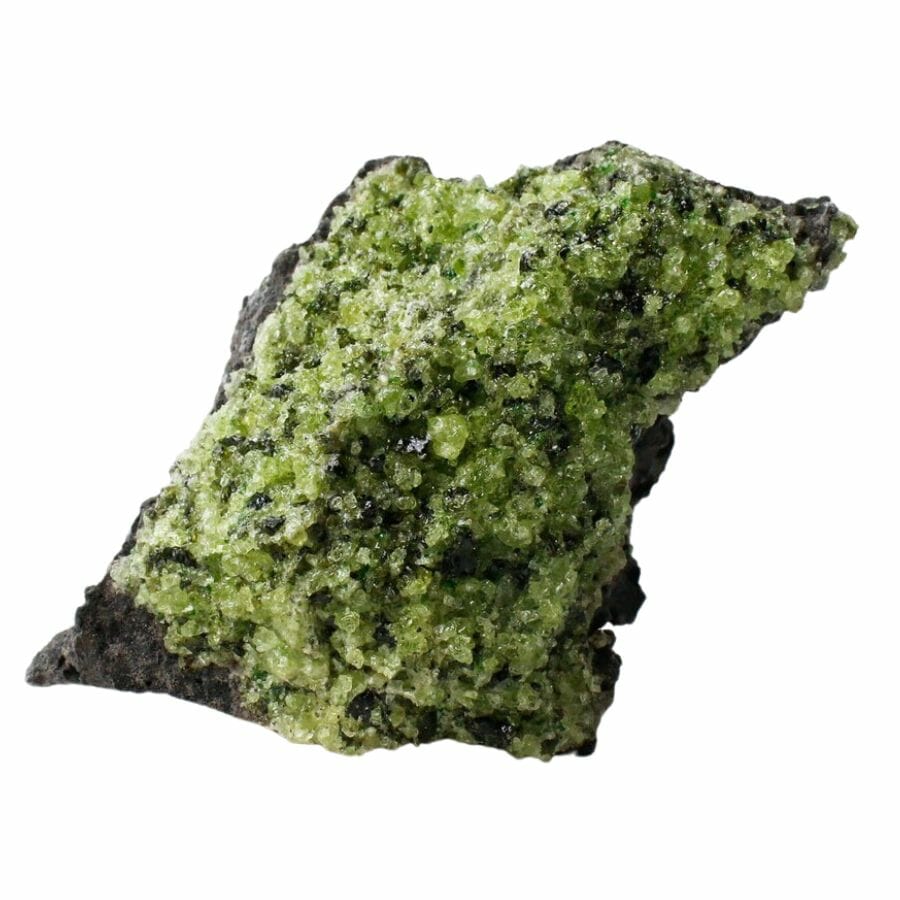
Among the many rocks and minerals found in Arizona, peridot stands out with its vibrant green sparkle. It’s a zesty, brightly colored gem that dazzles in the sunlight.
What’s cool is that peridot is one of the few gems that only comes in one color. But it can range from a yellowish-green to a deeper olive shade.
Now, let’s get to the magical part: how it forms, especially in a place like Arizona. Deep down in the Earth, way below our feet, there’s a lot of heat and pressure. Under these extreme conditions, peridot crystals begin to grow in the molten rock.
Sometimes, this molten rock with peridot in it shoots up to the surface in violent volcanic eruptions. As the lava cools and hardens, voilà! We have rocks with peridot crystals inside them.
Arizona has a history of these volcanic activities, which is why it’s a hotspot for peridot.
Historically, peridot was cherished by ancient Egyptians and believed to keep away evil spirits. In modern times, many love it for its bright color, and it’s even the birthstone for August babies!
Where you can find peridot in Arizona
- San Carlos Apache Indian Reservation
- Peridot Mesa (Peridot occurrence 38), San Carlos
- Peridot Canyon, San Carlos
Obsidian
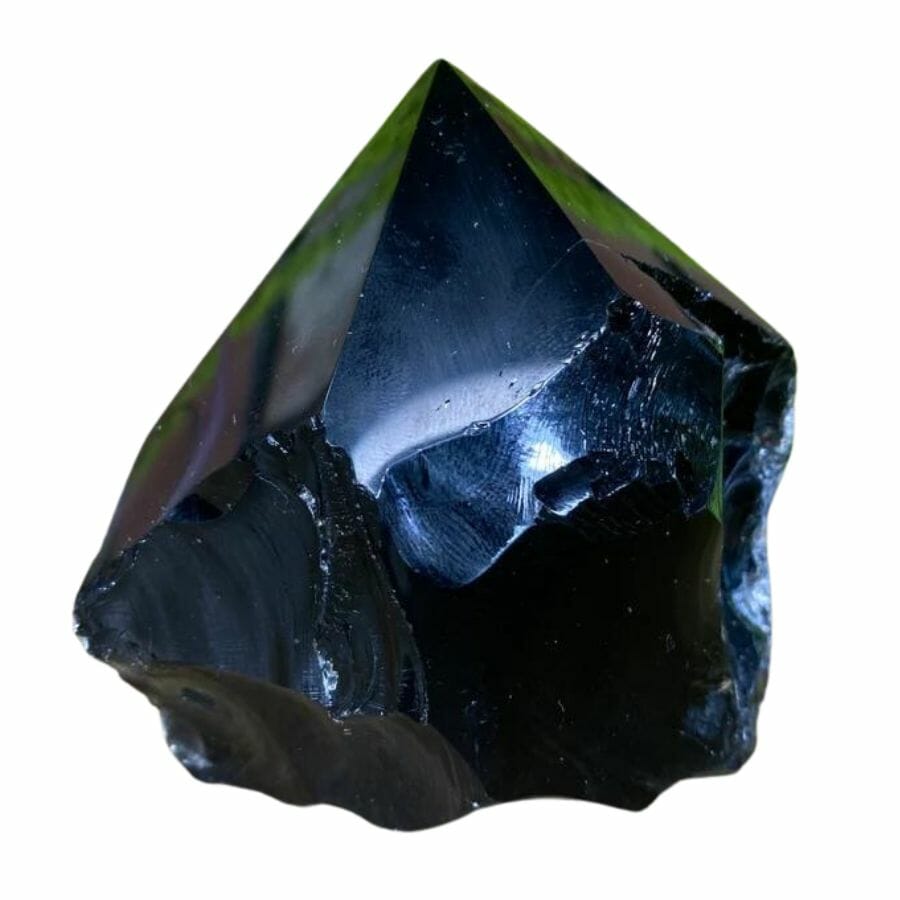
The diverse range of gemstones found in Arizona makes the state a paradise for rock enthusiasts and collectors. Obsidian is one of the best examples of the gems you can find in this state.
Obsidian is like glass, but it’s usually a deep black, sometimes with streaks of other colors. It has this glassy look because it’s actually volcanic glass!
Here’s the lowdown on how obsidian forms, especially in cool places like Arizona. When volcanoes erupt, they spew out a hot, gooey material called lava.
Now, if this lava cools down super quickly, it doesn’t have time to form regular crystals like other rocks.
Instead, it hardens swiftly and turns into this shiny, smooth obsidian.
Because of Arizona’s history of volcanic activity, you can find obsidian in various parts of the state. With the right conditions, Arizona’s volcanoes provided the perfect obsidian-making recipe!
Ancient folks made tools and weapons out of obsidian because it can be chipped into super sharp edges. Nowadays, it’s popular for making jewelry and artwork.
Plus, some people believe obsidian has protective qualities, like a shield against bad vibes.
Where you can find obsidian in Arizona
- Chiricahua Mountains, Cochise County
- Superior, Pioneer Mining District, Pinal Mountains
- Superior Obsidian locality, Superior, Pioneer Mining District, Pinal Mountains
Arizona has a lot of other areas where you can find obsidian. See our guide below:
Aragonite
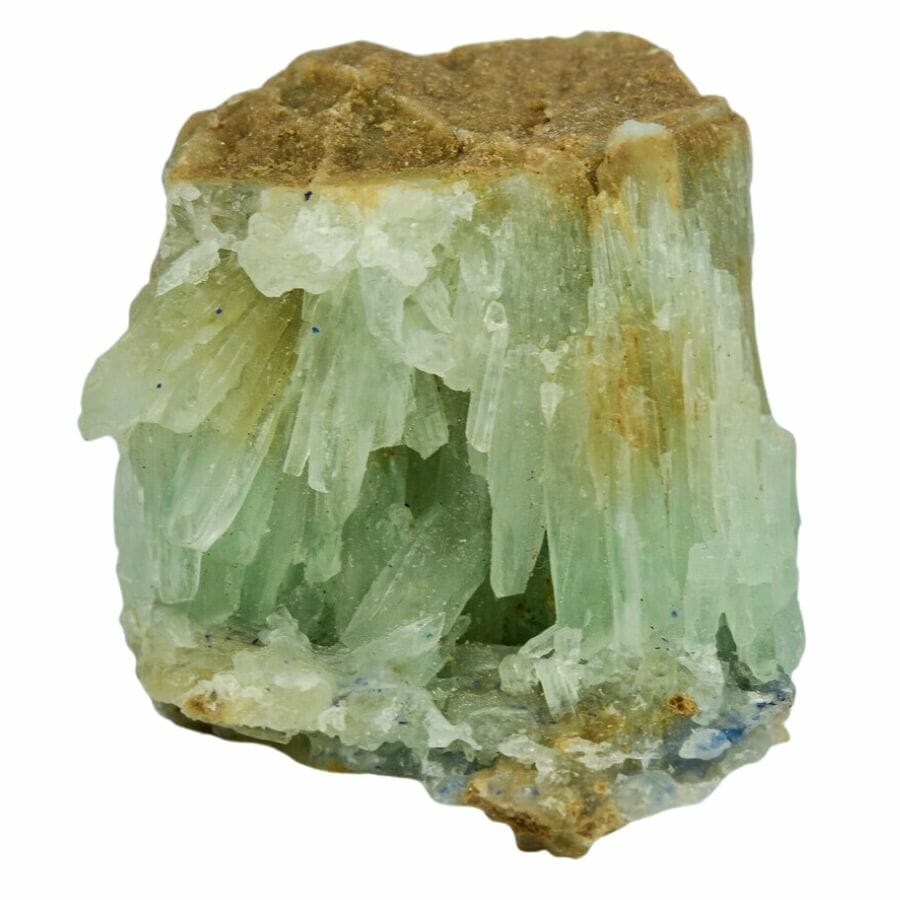
Aragonite might not have the fame of diamonds or rubies, but it’s a rockstar in its own right. Among the various types of rocks found in Arizona, aragonite stands out with its lovely crystal shapes.
It’s often white or clear but can sometimes sport shades like yellow, red, brown, and even a nice baby blue. It has a neat crystal shape, often looking like a burst of needles.
Aragonite forms in low-temperature environments like caves, hot springs, and even near certain salt lakes. When water with calcium carbonate drips in caves or evaporates in springs, it leaves behind these awesome aragonite crystals.
Arizona, with its varied landscapes, offers some sweet spots for aragonite formation. Its caves and hot springs have just the right conditions for this mineral to show up and show off.
Aragonite’s unusual crystal shapes are a big part of its charm. It’s often used for jewelry and decorations, and those who collect minerals find it a must-have for their collection.
Some even believe that aragonite has special energy or healing properties.
Sometimes, it’s also crushed up and used as substrate in aquariums because it helps balance the water’s pH level, making it great for fishy friends.
Where you can find aragonite in Arizona
- San Francisco River area, Clifton
- Copper Canyon, Camp Verde, Camp Verde Mining District
- Silver Bell Mine, Mineral Mountain, Silver Bell Mining District
The Crystals Found in Arizona
Here we have a list of fascinating crystals that you might come across in Arizona. You can also check out this comprehensive guide if you want to check out the other crystals you might find in the state:
Bornite
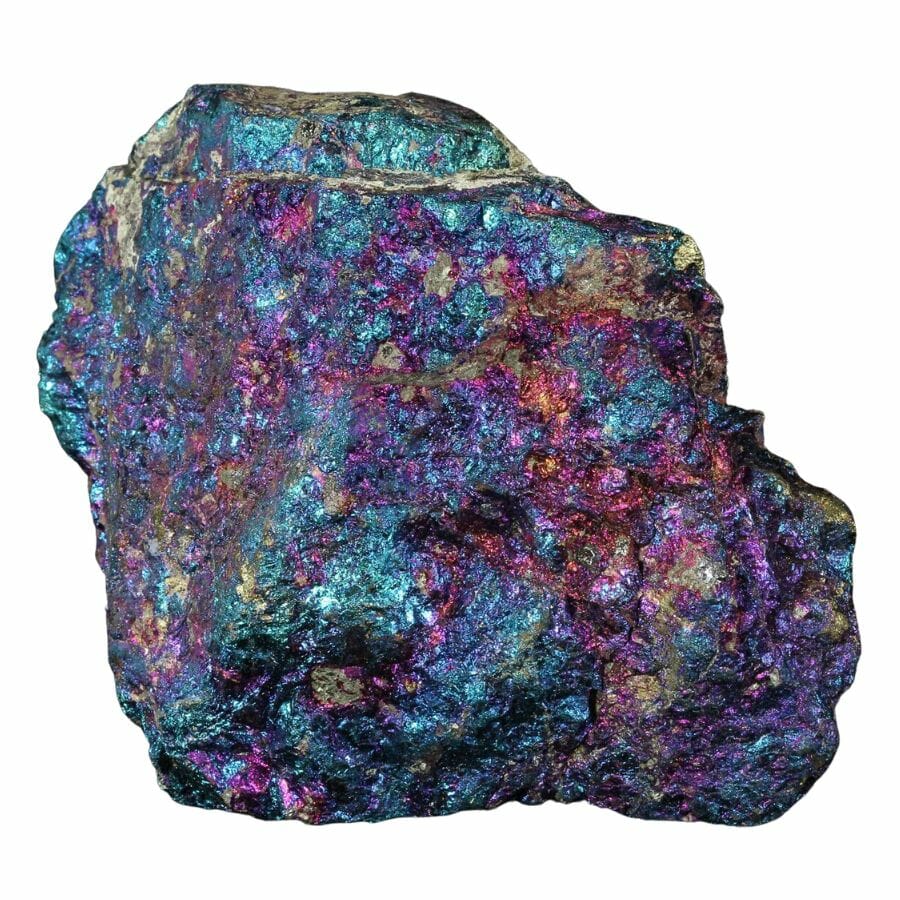
Bornite is an amazing mineral that sometimes goes by a super fun name: “peacock ore!” When you see it, you’ll totally get why. It flashes colors like purple, blue, and pink when it tarnishes, much like a peacock’s flashy feathers!
This mineral typically forms in igneous rocks. These are rocks that come from cooled-down magma or lava. Now, if you mix that with water containing certain minerals, and let them all react, bornite starts to form.
Arizona provides just the right setting for bornite to develop. That’s why if you explore the state, there’s a good chance that you’ll come across bornite.
This mineral’s dazzling colors make it a favorite among mineral collectors. It’s like having a little rainbow in a rock!
But that’s not all. Bornite is also an important ore for copper. That means we can extract copper from it, which we use in all sorts of stuff like wires and coins.
Where you can find bornite in Arizona
- Superior area, Superior Mining District
- Golden Rule Mine, Dragoon District
- Copper Queen Mine, Mayer, Agua Fria Mining District, Bradshaw Mountains
Pyrite
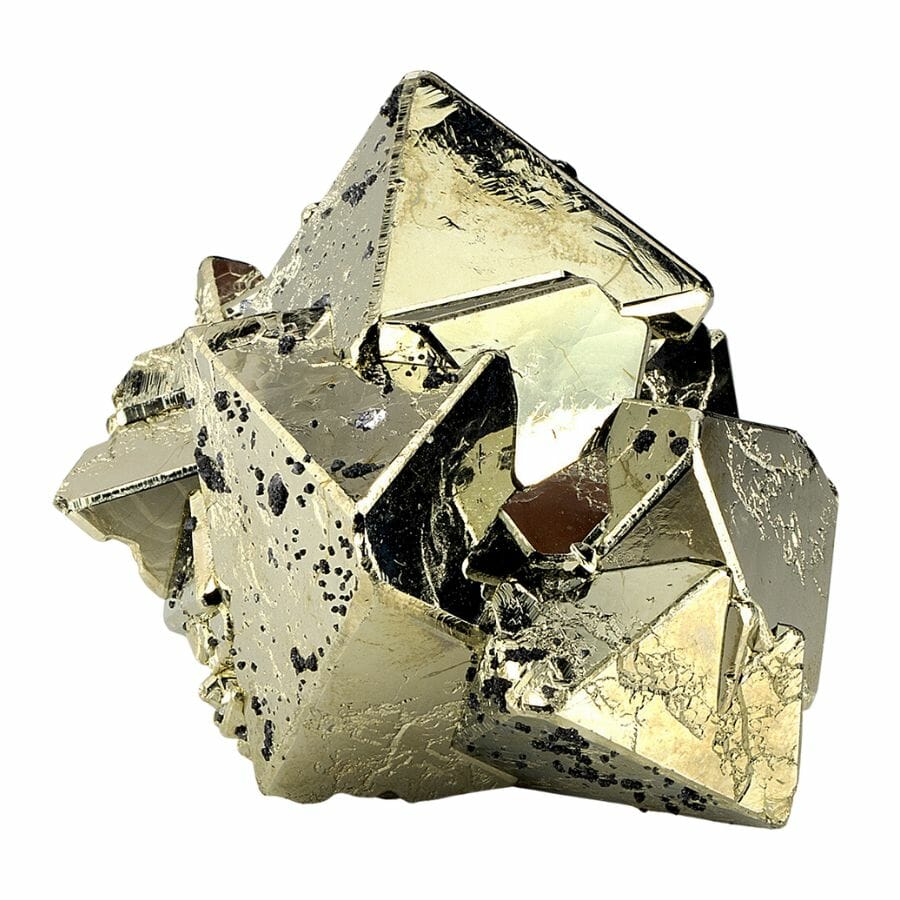
Pyrite is often called “fool’s gold” because of how similar it looks to the precious metal. It might trick you with its shiny, gold-like appearance, but it’s a unique and awesome mineral all on its own.
This mineral forms when iron and sulfur bond together under certain conditions. It can grow in all sorts of places like sedimentary rocks, volcanic rocks, and even in coal beds.
Arizona, with its diverse geology and plenty of underground magic, provides some excellent spots where pyrite can form. That’s why the variety of crystals found in Arizona attracts both seasoned geologists and curious explorers alike.
Aside from its cool, golden shimmer, pyrite has some other neat uses. Long ago, people used it to create sparks, kind of like an ancient lighter.
Also, because of its metallic look, it’s a hit among mineral collectors and is often used in jewelry and decorations.
Where you can find pyrite in Arizona
- Jack White Mine, Winifred Mining District, Phoenix Mountains
- Black Mesa, Mohave County
- Black Pearl Mine, Loco Creek, Eureka Mining District
Quartz
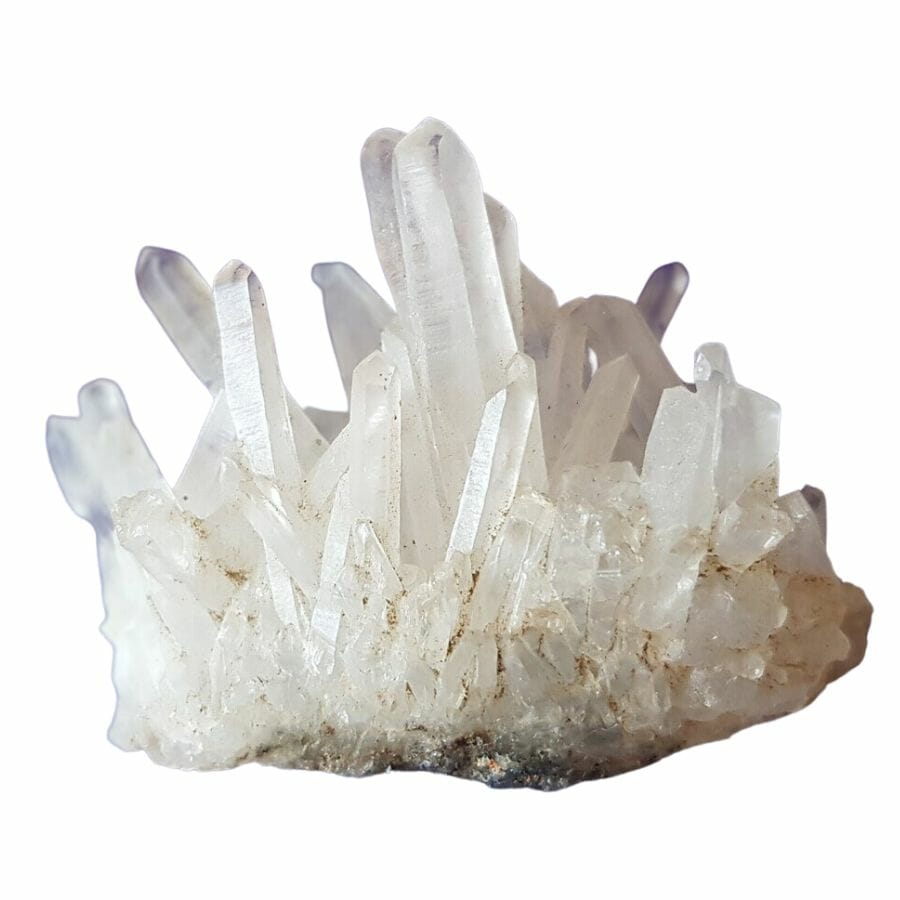
Quartz is clear and sparkly, but it can also come in a rainbow of colors, from pretty purples to rosy pinks and even smoky browns.
It loves to grow in cracks and spaces inside rocks. When hot water filled with dissolved minerals moves through these spaces and then cools down, quartz starts to crystallize.
Think of it like sugar crystallizing in a supersaturated solution to make rock candy.
Arizona has a lot of varied landscapes and a lot of geothermal activity, which is why you’ll find quite a bit of quartz here.
Quartz is super versatile. You can find it in everyday items like watches, and it even helps power electronics.
People have also been using quartz for jewelry for ages. Its sparkle and variety of colors make it a big hit. Plus, many believe that different types of quartz have special energies or healing properties.
Where you can find quartz in Arizona
- Castle Hot Springs
- Coolidge Dam
- Agua Fria River (stream), Bradshaw Mountains
Wulfenite
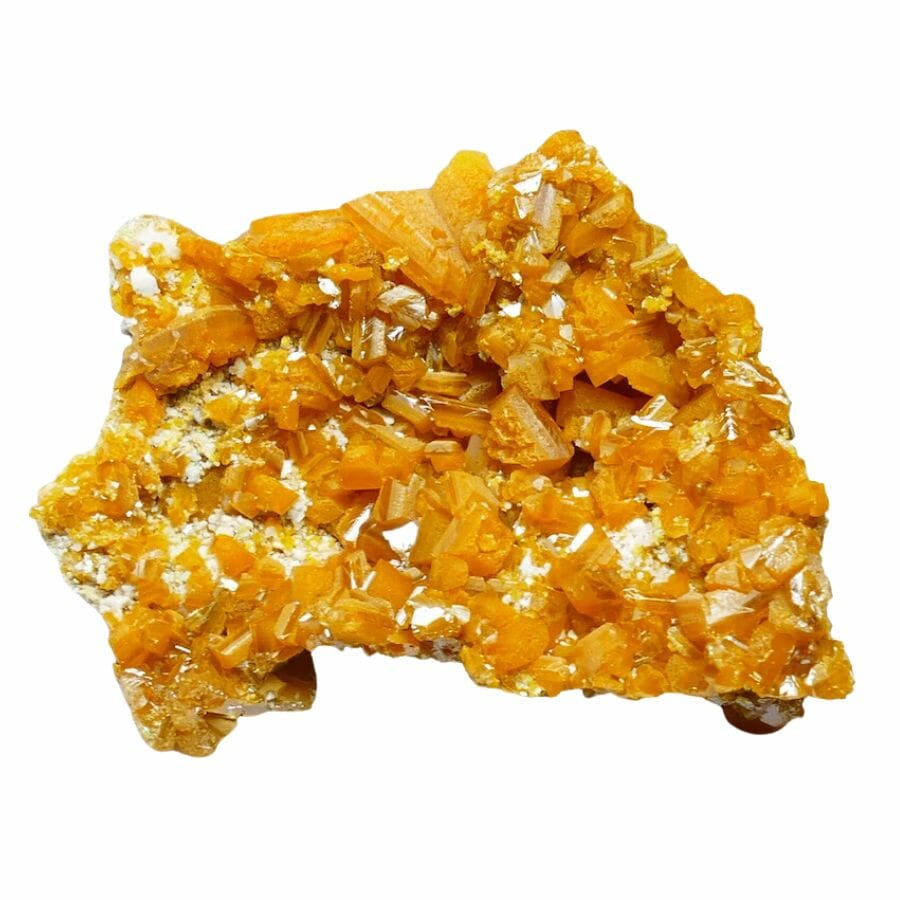
Wulfenite is a true attention-grabber with its bright orange and yellow colors. It forms in flat, square-shaped crystals that sometimes look like little windows.
Arizona, known for its rich array of rocks and minerals, is a good place to look for wulfenite. In fact, it’s the state mineral!
Wulfenite forms in what geologists call “oxidized zones” of lead deposits. That’s a fancy way of referring to areas where lead has reacted with oxygen and other things over time.
When conditions are just right, with the perfect mix of elements and the right environment, wulfenite starts to crystallize.
With its bright colors and cool crystal shapes, wulfenite is a favorite for mineral collectors. And while it’s not used much industrially today, in the past, it was an important ore for getting lead and molybdenum.
Where you can find wulfenite in Arizona
- Rustler Park, Cochise County
- Pope Mine, Mohave County
- Junction Mine, Gold Basin Mining District, White Hills
Covellite
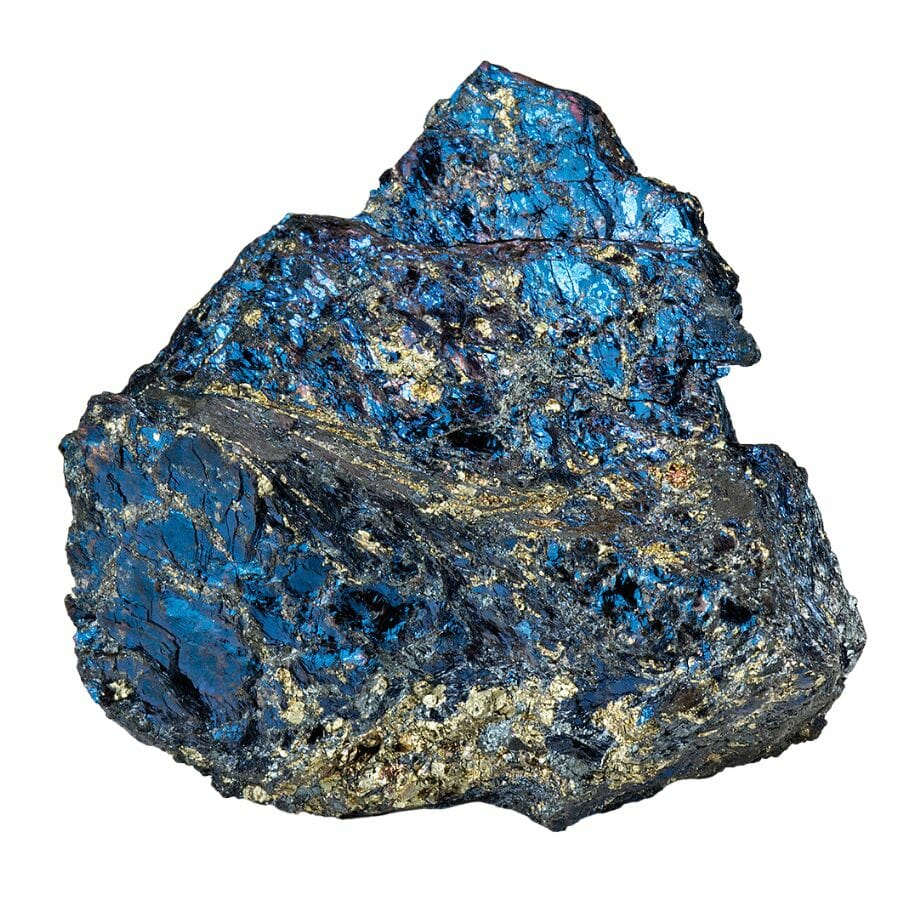
Covellite has a unique dark blue-purple sparkle that makes it stand out in the rock crowd. It’s like a splash of midnight sky wrapped in a stone.
When copper minerals are exposed to water and oxygen, they can change or “oxidize.” As the copper minerals transform, they can turn into covellite. This process takes a really long time, but it’s worth the wait!
With Arizona’s rich history of copper mining and its unique underground conditions, it’s no wonder that covellite can be found here.
Covellite’s deep blue-purple sheen makes it a favorite among rock collectors. Imagine having a piece of the night sky in your hand! Plus, jewelers often use it to create eye-catching pieces.
On top of looking amazing, some folks believe that covellite can boost creativity and help with communication.
Where you can find covellite in Arizona
- Aravaipa Mining District, Graham County
- Rowley Mine, Theba, Painted Rock Mining District, Painted Rock Mountains
- Boss Mine, Goodsprings Mining District, Spring Mountains
Dioptase
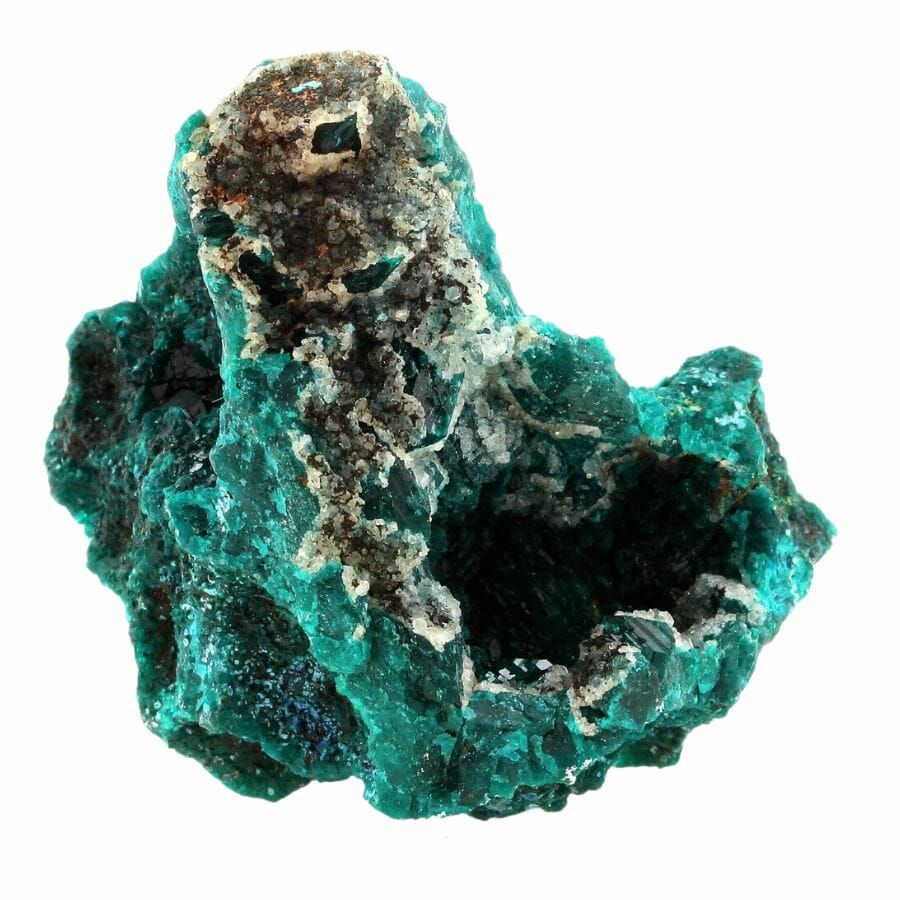
Dioptase, with its vibrant green sparkle, is one of the most eye-catching crystals found in Arizona. Imagine a gem with the vibrant green of a rainforest, and you’ve got dioptase!
This mineral is born when copper-rich water reacts with silica and certain conditions deep in the Earth. This special mix, under the right temperature and pressure, creates those stunning green crystals.
Arizona, with all its awesome geothermal activities and copper deposits, is just the right kind of place for dioptase to grow.
Dioptase’s brilliant color is a total crowd-pleaser. Mineral collectors go bananas for it. Plus, while dioptase looks like an emerald, it’s actually way rarer, which makes it super special.
People also value it for its healing properties. Some believe that this gem can bring peace, balance, and emotional healing.
Where you can find dioptase in Arizona
- Bonanza Mine, Bonanza and Golden Eagle Mine group, Martin Peak, Salome
- Johnson Camp, Gunnison Copper Project, Cochise Mining District
- Eagle Eye Mine, Moore Mine group, New Water Mining District, New Water Mountains
Selenite
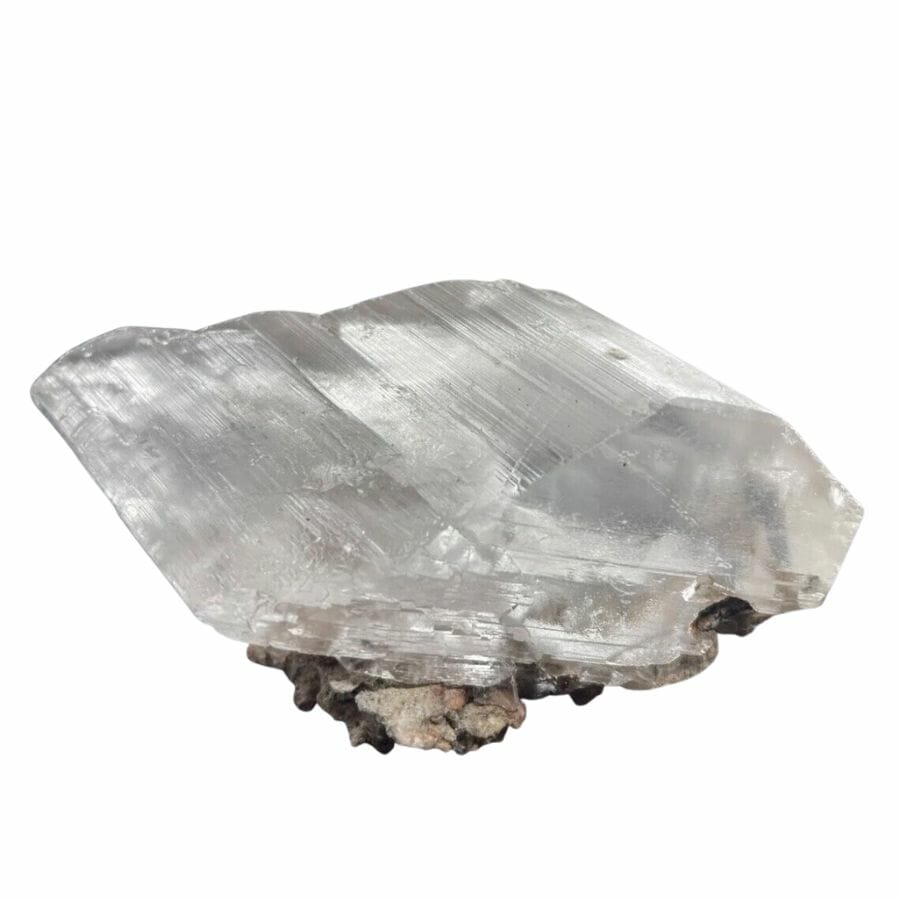
Picture a crystal that’s so clear and sparkly, it looks like frozen moonlight. That’s selenite for you!
Selenite is a type of gypsum, and it loves to form in watery spots, like salt flats or areas that once had ancient lakes. When water evaporates from these places, selenite starts to crystallize.
Arizona, with its deserts, once-upon-a-time lakes, and unique below-the-ground conditions, is a dream home for selenite to grow.
Those clear, shiny crystals can grow super big, making them a hit among people who love collecting minerals. Plus, it’s sometimes used in decoration because of its lovely glow.
Selenite is also popular for its peaceful energy. Many believe that it can clear negative vibes and bring calm to a space.
Where you can find selenite in Arizona
- Toltec Divide Area Gypsum deposit, Winslow, Winslow Mining District
- Lucky 44 claim, Mohave County
- Monument No. 2 Mine, Monument No. 2 channel, Yazzie Mesa, Cane Valley Mining District
The Most Valuable Rocks and Minerals in Arizona
These remarkable specimens aren’t just valuable in terms of money, but also in the stories they whisper about the Earth’s past. Let’s check out the world of Arizona’s most precious rocks and minerals.
Turquoise
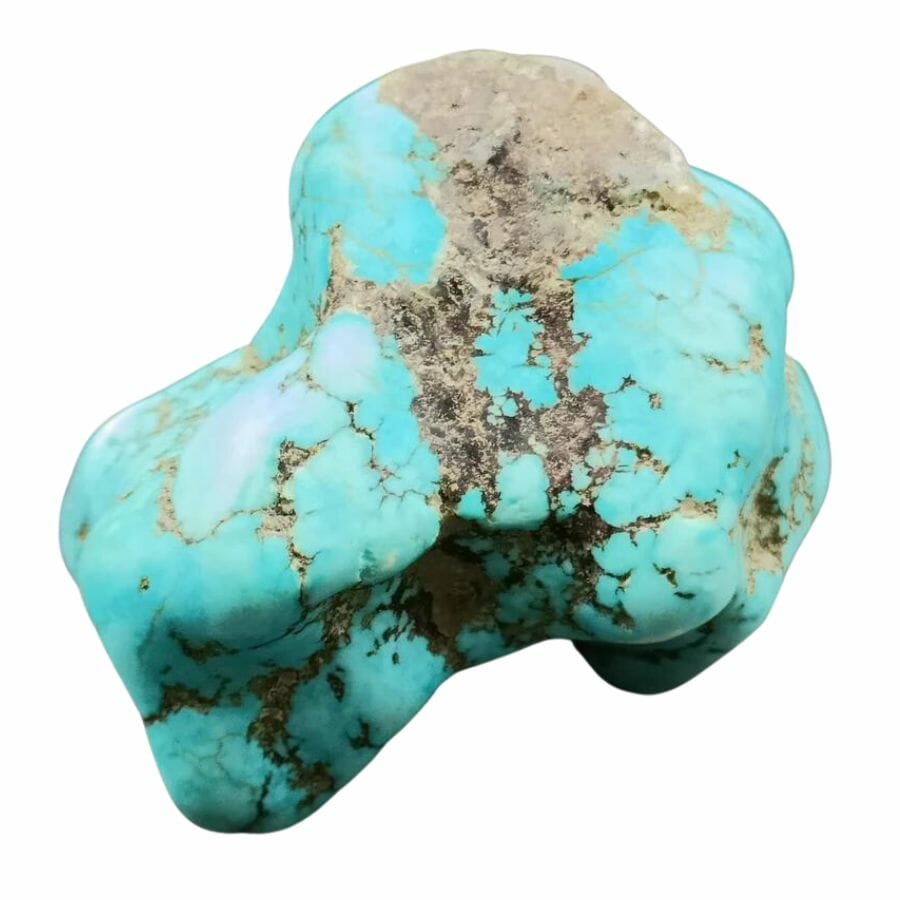
Turquoise is a rock with shades of blue and green, often mixed with cool patterns. It looks as cool as a summer pool!
Turquoise forms in areas with dry climates, like deserts and places where it’s often sunny. When rainwater, which has some specific minerals dissolved in it, seeps into the ground, it can react with certain rocks.
With enough time, all these ingredients create turquoise.
The bright, unmistakable colors of turquoise make it a favorite for jewelry. Imagine wearing a piece of the Arizona sky around your neck!
Native American cultures have also cherished turquoise for centuries, using it in beautiful artwork, jewelry, and even for spiritual ceremonies. People believe it has healing powers and can bring good luck.
Arizona turquoise is known to be some of the best in the world! That’s why it can fetch a hefty price tag.
Where you can find turquoise in Arizona
- Canyon Creek turquoise deposit, Canyon Creek, Fort Apache Indian Reservation
- West Side Mine, Tombstone Mining District
- Morenci Mine, Morenci, Greenlee County
Fire Agate
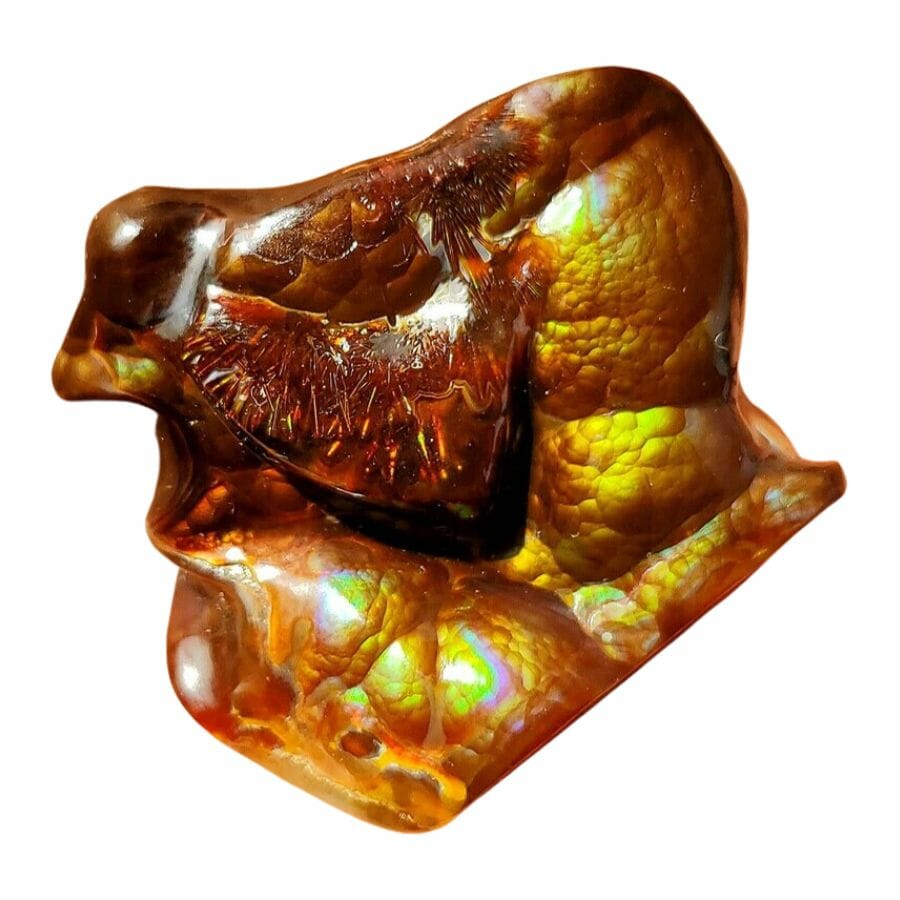
Fire agate is a gem that’s as fiery and exciting as its name suggests. It’s a stone that glows with a rainbow of warm colors, just like flames dancing in a fireplace.
Fire agate forms in volcanic areas, where hot molten rock once flowed. Over time, layers of silica and water build up in the cracks and bubbles of the old lava.
These layers stack up like pancakes and, with the magic touch of heat and pressure, turn into the glowing fire agate.Guess what state has lots of this volcanic history? You got it – Arizona!
You’d be surprised at how many valuable rocks in Arizona are just waiting to be discovered by keen explorers!
Fire agate has showy colors that make it a superstar for jewelry. It’s like wearing a bright flame! People also value it for its unique play of colors, where the stone seems to shimmer and change as you move it.
Plus, some believe fire agate has the power to energize and guard its wearer.
Where you can find fire agate in Arizona
- Deer Creek Fire Agate Mine, Graham County
- Black Hills Rockhound Area, Black Hills
- Saddle Mountain, Maricopa County
Petrified wood
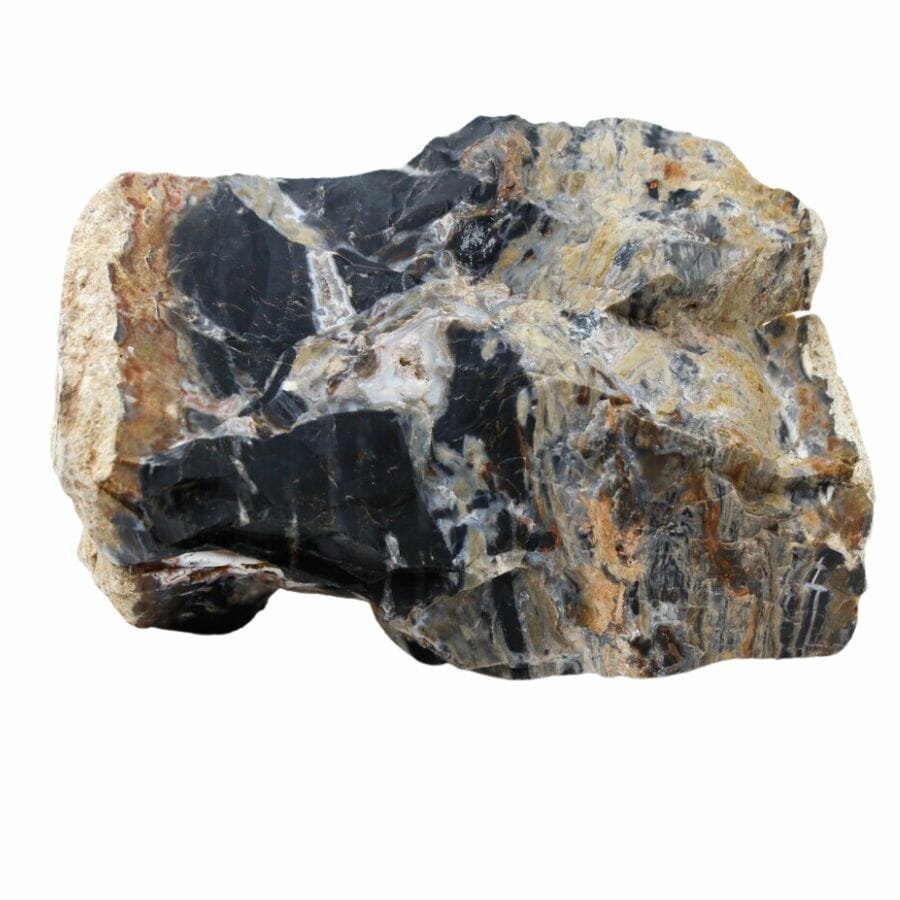
Imagine a tree that turned into stone. Sounds crazy, but it’s true! Petrified wood is wood that has been turned into rock.
When trees die and get buried under layers of mud, ash, or other stuff, they get protected from the usual rotting process. Instead of rotting away, the wood’s cells slowly get replaced by minerals like silica.
Over a very long time, these minerals turn the wood to stone, while still keeping the tree’s shape and even its rings!
Arizona, with its unique combo of ancient forests, volcanic ash, and groundwater, became one of the best places for creating petrified wood.
Having a piece of petrified wood in your hand is like holding a piece of ancient history. This is why it’s one of the most valuable rocks in Arizona.
In places like Arizona’s Petrified Forest National Park, you can even see giant logs of petrified wood that are millions of years old.
People also use slices of petrified wood in jewelry and decorations because it’s just so beautiful. Petrified wood can show off amazing colors, from deep reds and purples to shimmering blues and greens.
Where you can find petrified wood in Arizona
- Unnamed Petrified Wood localities, Springerville, Apache County
- Holbrook, Navajo County
- Black Mesa Coal Mine, Black Mesa
Arizona has a wealth of petrified wood! You can find more spots to explore in this guide:
Black Jade
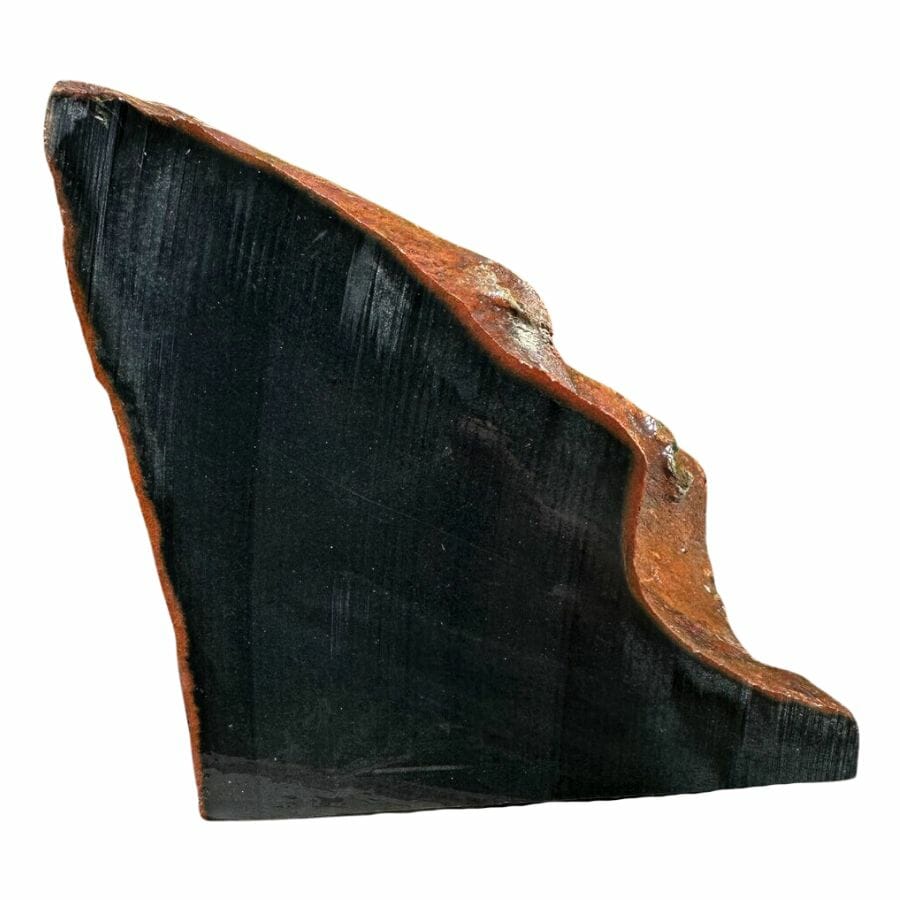
Think of a stone as dark as the night sky, but as shiny as a star. That’s black jade, and it’s a real gem!
Jade isn’t just one mineral, but two: nephrite and jadeite. These minerals form deep in the Earth when certain rocks melt and mix together. This melting pot of minerals gets pressed and squeezed under loads of pressure until jade is formed.
Black jade develops because of the presence of graphite or iron. Arizona is one of the places in the world that’s known to produce black jade.
This stone has a deep, dark color that’s mesmerizing and looks super sleek in jewelry. Black jade has been used for centuries by many cultures for carvings, statues, and amulets.
People believe that it has protective qualities, keeping bad vibes away. Plus, because it’s tougher than steel, it’s super durable and can last a really long time.
Where you can find black jade in Arizona
- Bradshaw Mountains
How to Identify The Rocks and Minerals Found in Arizona
Arizona rock identification doesn’t have to be a complicated or expensive process. With some simple tools, most of which you’ll find around the house, you can get one step closer to identifying mystery rocks and gems.
Test the hardness
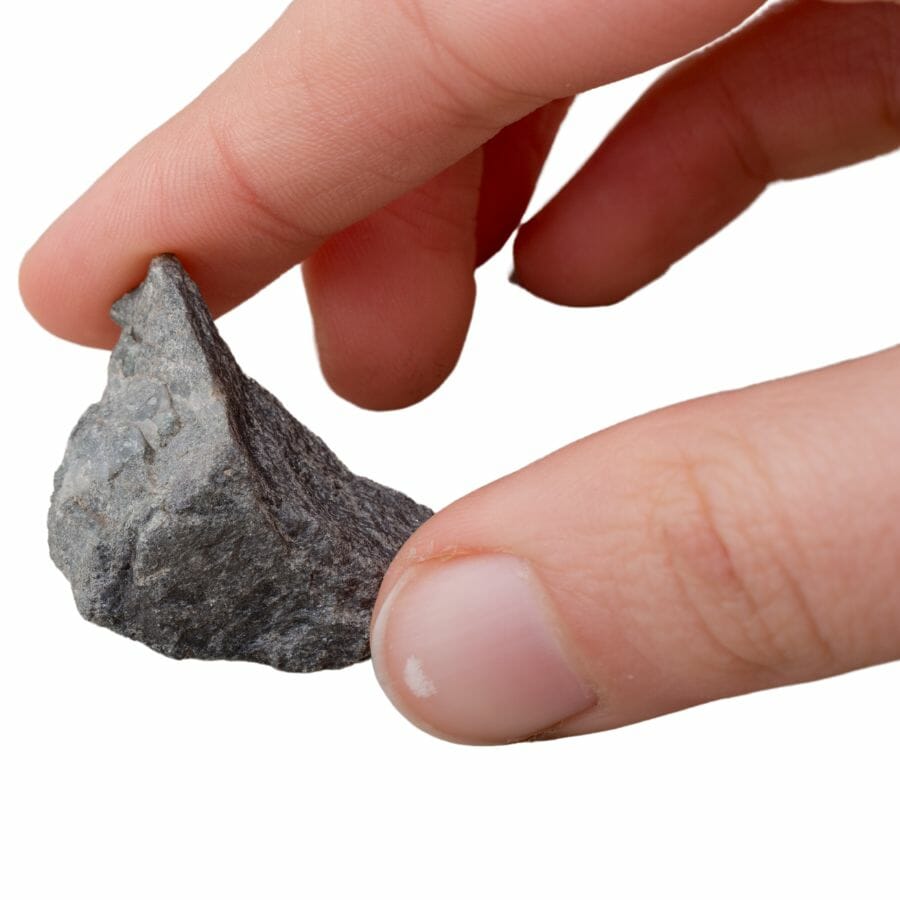
For this test, you’ll need a Mohs hardness scale cheatsheet and a few simple tools.
Here’s the deal: grab your rock or mineral and try scratching it with your fingernail, which has a hardness score of 2.5. If your fingernail leaves a mark, the rock is not very hard. If it doesn’t, you’re looking at a tougher specimen.
Now, for a bit of a challenge, use a shard of glass. Remember that glass has a hardness score of 5.5. If your rock scratches the glass, it’s harder than glass. But if the glass wins the battle, your rock is softer.
Last but not least, let’s bring in the big guns – a steel nail. A steel nail has a hardness score of 6.5, and it’s tougher than a lot of other objects. If the steel nail manages to scratch your rock, then your rock is softer than 6.5 on the hardness scale.
This scratch test is like a friendly competition between your rocks and some everyday things. It’s a fun and hands-on way to figure out the hardness of rocks and minerals. Doing this can permanently damage a rock, so make sure to be careful.
Check for magnetism
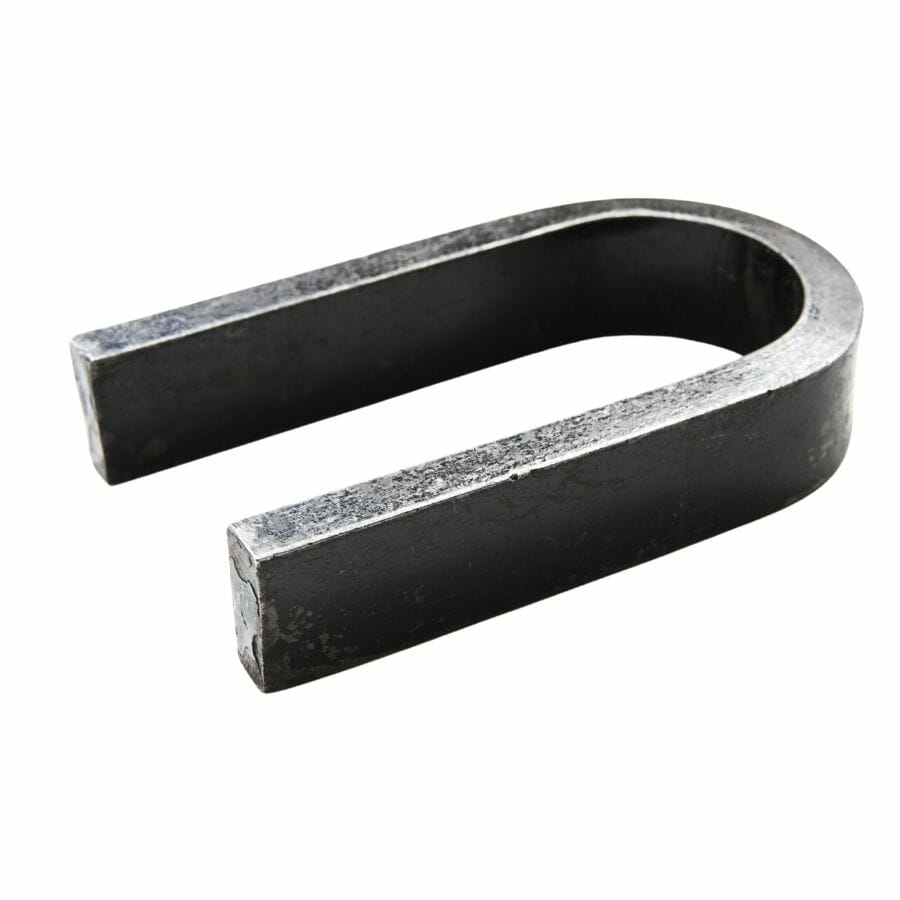
Grab a magnet and put it close to the rock or mineral you’re checking out. If the rock sticks to the magnet, it might have iron in it.
See, most minerals with iron in them are magnetic. But if the rock doesn’t stick, then it’s probably not carrying much iron.
Now, not all rocks with iron are magnetic, and not all minerals without iron won’t stick. It’s a bit of a rule-of-thumb thing.
Also, keep in mind that some gems, like diamonds or quartz, won’t respond to magnets because they don’t have much iron in them.
So there you have it! Using a magnet is a nifty way to give you a hint about what’s in the rock or mineral. But remember, it’s just one piece of the puzzle. To fully know what you’re holding, you might need to explore a bit more.
Conduct a streak test
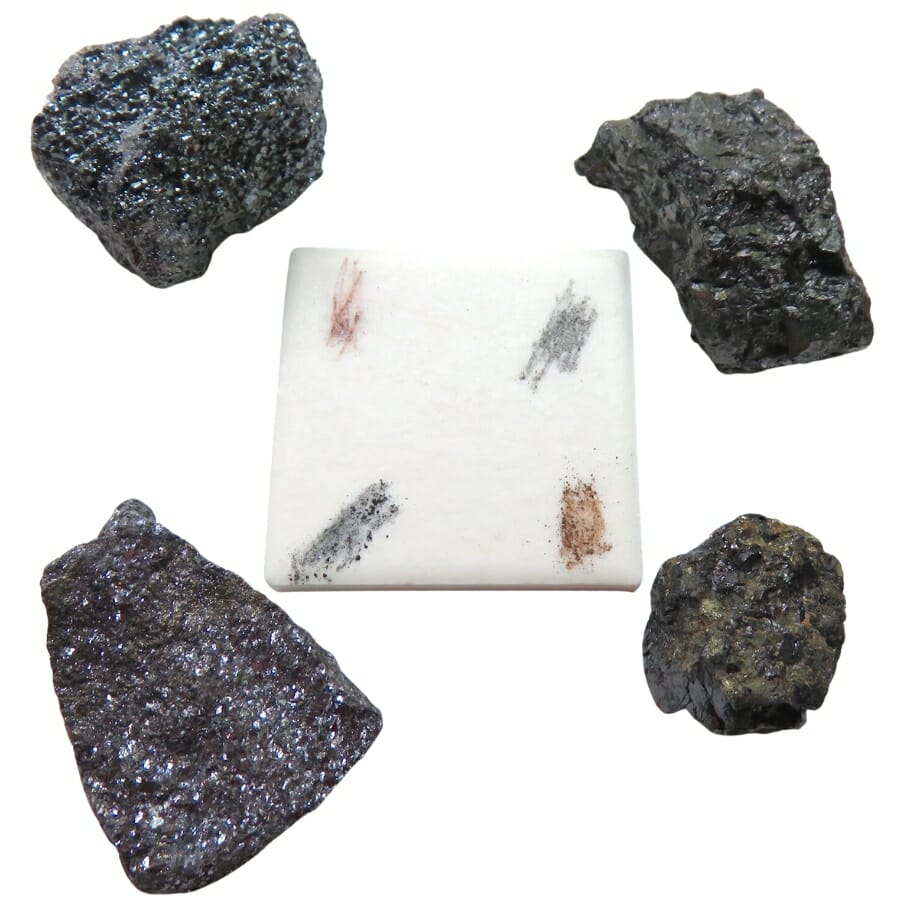
Every mineral has a streak, which is the color of the powder it leaves behind when you scratch it on something rough. You can use an unglazed porcelain tile, known as a streak plate.
It might surprise you, but a mineral’s streak color can be different from its surface color.
So, grab your mineral and give it a scratch on the streak plate. What color is the powder? That’s its streak color!
Let’s say you have a reddish mineral, but it leaves a white powder when you scratch it against the streak plate. That means that its streak is white.
Minerals that look very much alike can have different streak colors. This can help you identify the mineral you’re working with
A streak test won’t give you all the answers, but it’s definitely a cool tool in your Arizona rock identification toolbox.
Carefully test with acid
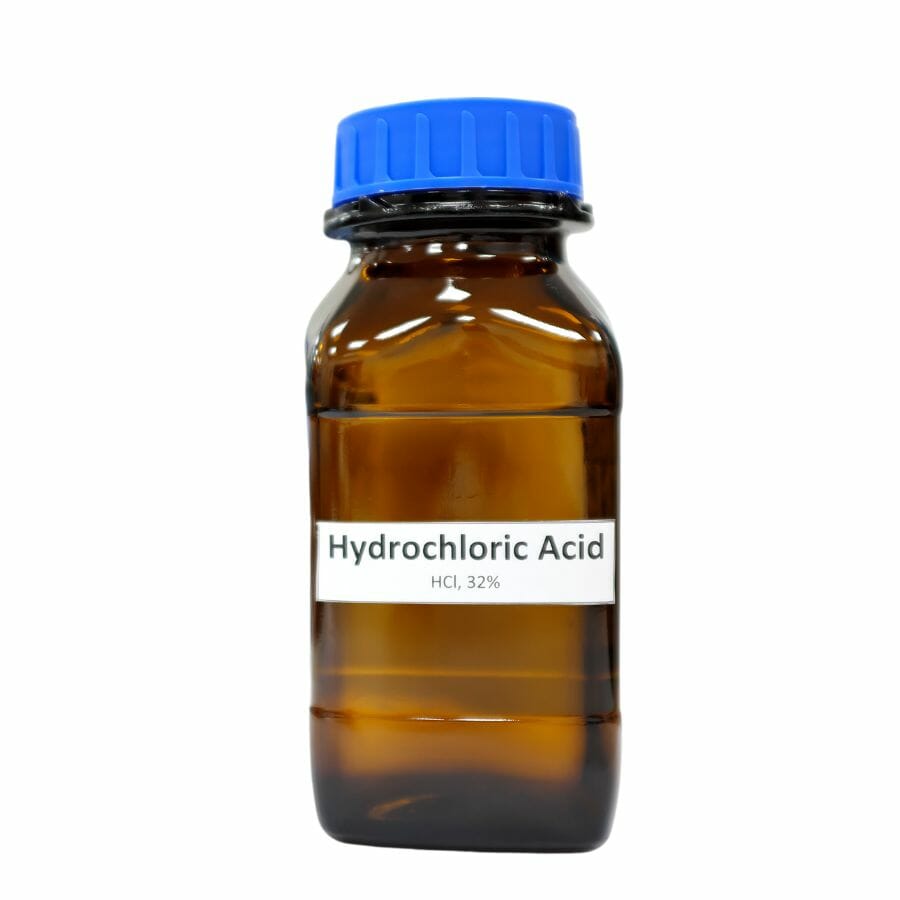
Different minerals react differently with acids. Take a little bit of your rock or mineral and drop a tiny amount of acid on it. If it fizzes, bubbles, or reacts, you’ve got a clue about what’s in there!
For example, if your rock gets all bubbly, it could have calcium carbonate in it, like limestone. But if it stays calm, then it might not have much of that in it.
Now, before you dive into the acid, make sure to stay safe. Use gloves and safety goggles, and remember that some acids can be strong and dangerous.
Feel the weight
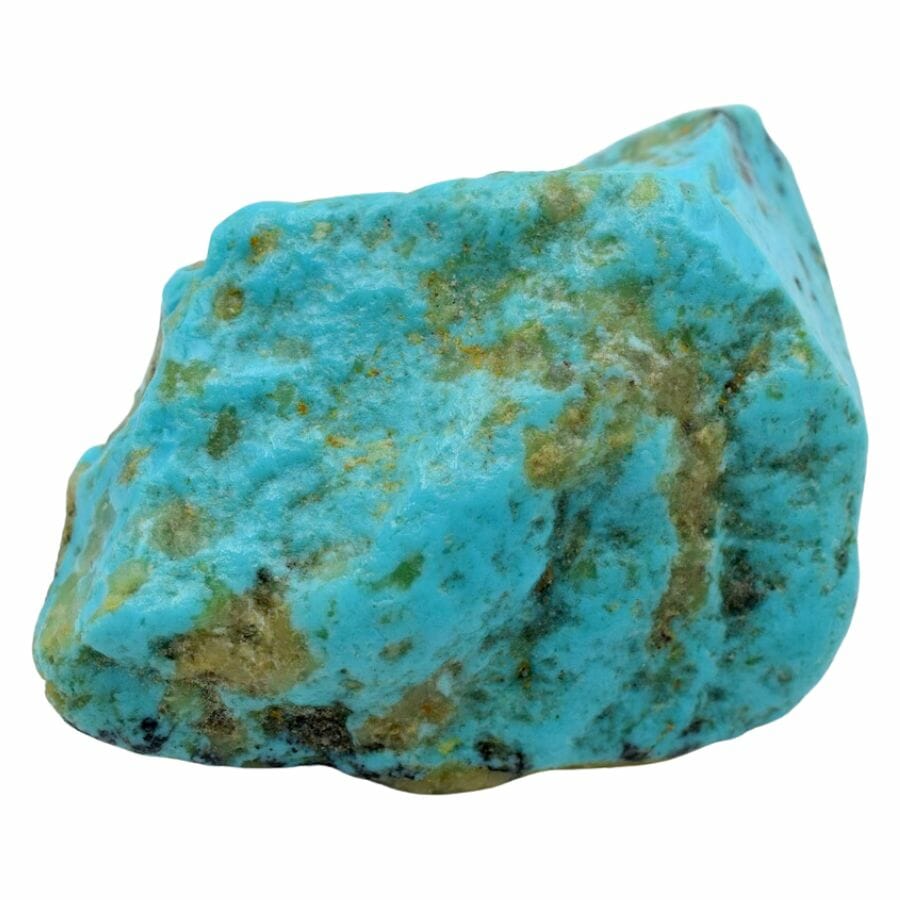
Grab your rock and hold it in one hand. Now, grab another rock that you’re familiar with that’s also a similar size, like a stone from your yard. Hold one in each hand and compare their weights. Does one feel heavier? Or maybe one is lighter?
The trick here is that different rocks have different densities, which makes them weigh differently. Denser rocks with more minerals packed tightly inside are usually heavier, while rocks with more air spaces might be lighter.
Remember, the weight test is a handy tool to add to your rock identification skills. But keep in mind that size matters too – a small heavy rock might still weigh less than a big light rock.

